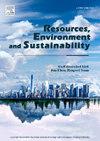农业可持续用水和排放管理:中国的水-排放-粮食关系
IF 12.4
Q1 ENVIRONMENTAL SCIENCES
引用次数: 0
摘要
研究水-排放-粮食关系(WEF nexus)对农业经济系统的可持续性至关重要。多区域投入产出(MRIO)模型为水-排放-粮食一体化协同管理提供了见解。本文基于RAS方法建立了面向农业的详细MRIO模型,该模型将农业部门分解为12个子部门。用水量和温室气体(GHG)排放量分配到整个供应链,以确定2017年世界经济论坛Nexus在中国的重点区域和路线。然后利用生产率指标对农业部门及其子部门的环境产出水平进行了分析。结果表明,农业部门表现出较强的WEF Nexus联系(系数为0.87),特别是在沿海和西南地区。水和排放之间的协同关系为执行综合管理战略提供了重大机会。73.3%的虚拟水和71.7%的实际排放集中在供应链的下游非农业部门,凸显了贸易传导对环境的重大影响。除中部和西南地区外,农业用水和排放生产率在空间上基本一致。东北和中部地区作为重要的农业产出区,水生产率和排放生产率较低,农业可持续发展面临较大挑战。因此,切实可行的措施应侧重于推动技术创新和应用,以提高农业生产中的用水效率和减少温室气体排放。本文章由计算机程序翻译,如有差异,请以英文原文为准。

Sustainable water and emissions management in agriculture: The water-emissions-food nexus in China
Studying the water-emissions-food nexus (WEF Nexus) is crucial for the sustainability of agricultural economic systems. The multi-regional input–output (MRIO) model provides insights for water-emissions-food integrated collaborative management. This study develops a detailed agriculture-oriented MRIO model based on the RAS method, which disaggregates the agricultural sector into 12 sub-sectors. The water consumption and greenhouse gas (GHG) emissions are allocated to the entire supply chain to identify the key regions and routes of the WEF Nexus in China for 2017. Then the environmental output level of the agricultural sector and its sub-sectors is analyzed using productivity indicators. Results demonstrate that the agricultural sector exhibits a strongly connected WEF Nexus (coefficient of 0.87), particularly in Coastal and Southwest regions. The synergistic relationship between water and emissions suggests significant opportunities for implementing integrated management strategies. 73.3% of virtual water and 71.7% of embodied emissions are concentrated in downstream non-agricultural sectors of supply chains, highlighting the substantial impact of trade transmission on the environment. The water and emissions productivity in the agricultural sector are spatially aligned except in the Central and Southwest regions. As significant agricultural output regions, Northeast and Central regions have lower water or emissions productivity, making sustainable agricultural development more challenging. Therefore, practical measures should focus on promoting technological innovation and its adoption to enhance water use efficiency and reduce GHG emissions in agricultural production.
求助全文
通过发布文献求助,成功后即可免费获取论文全文。
去求助
来源期刊

Resources Environment and Sustainability
Environmental Science-Environmental Science (miscellaneous)
CiteScore
15.10
自引率
0.00%
发文量
41
审稿时长
33 days
 求助内容:
求助内容: 应助结果提醒方式:
应助结果提醒方式:


